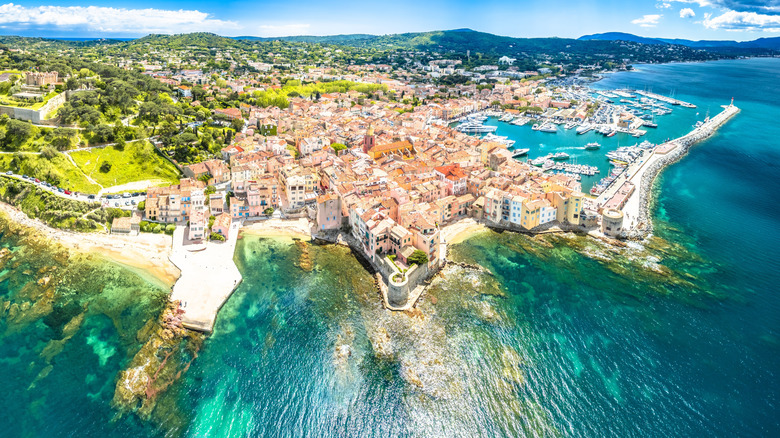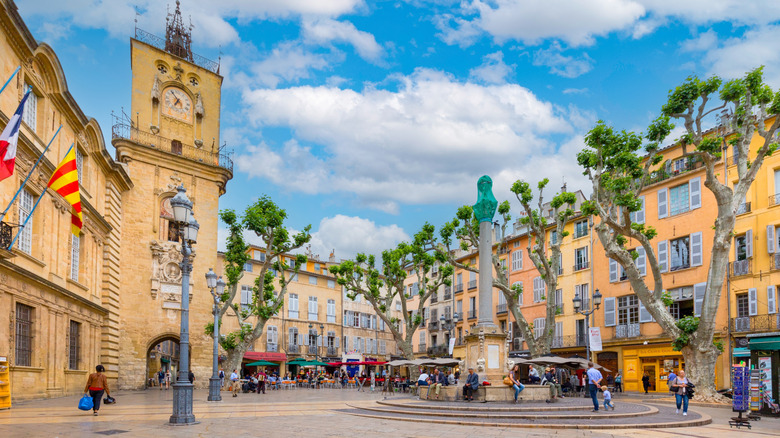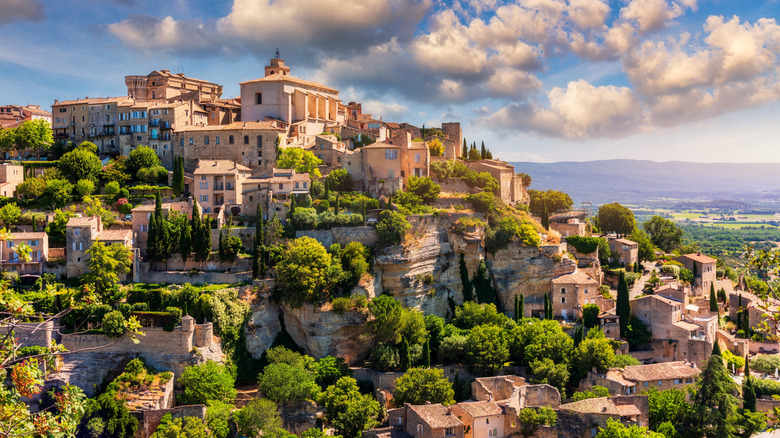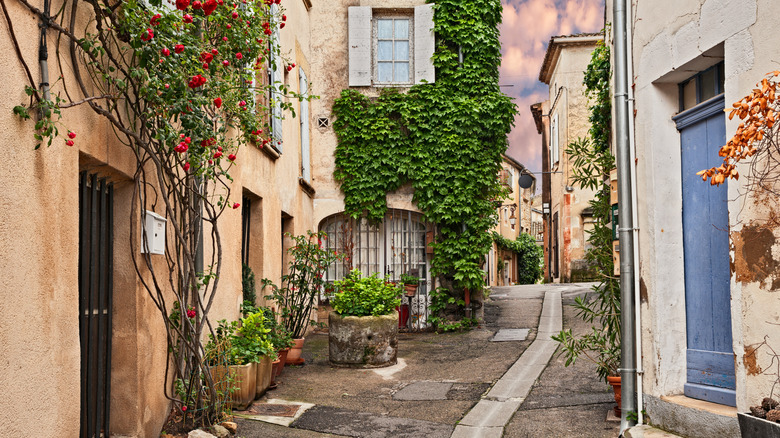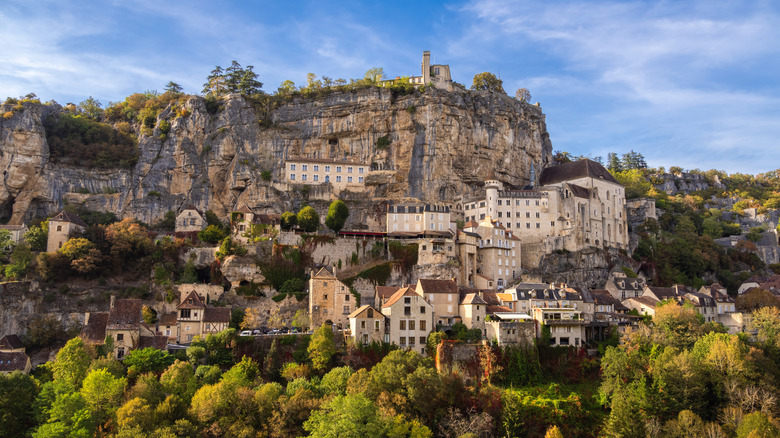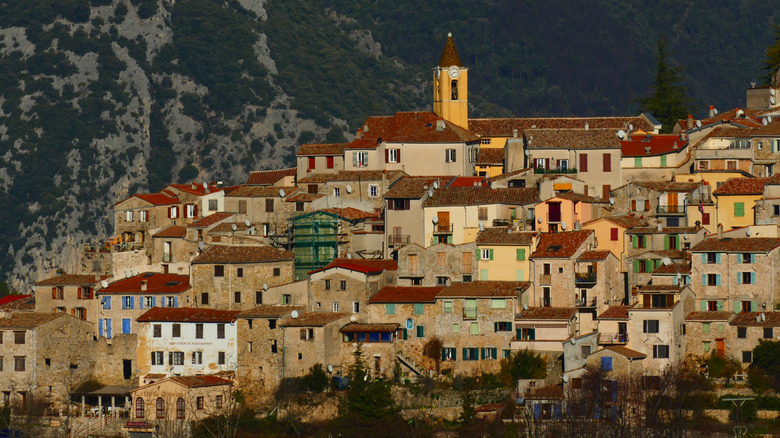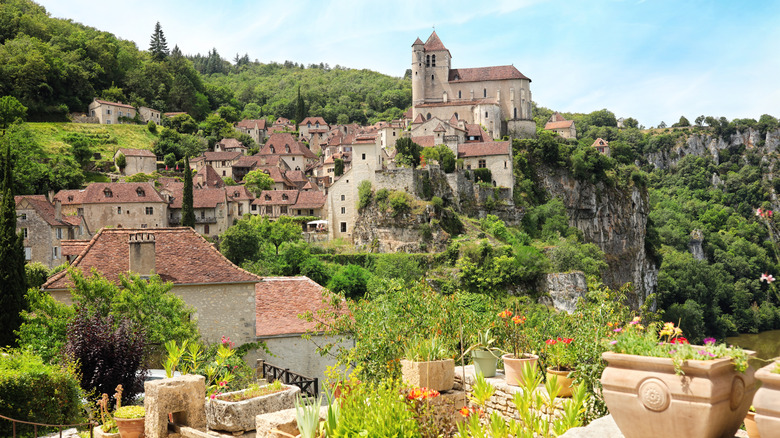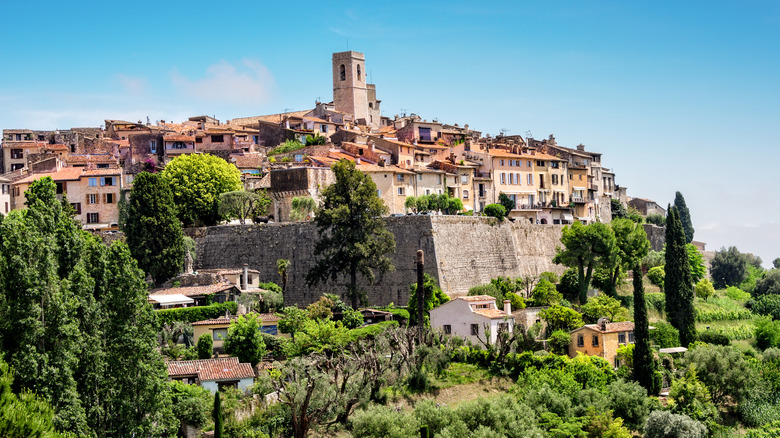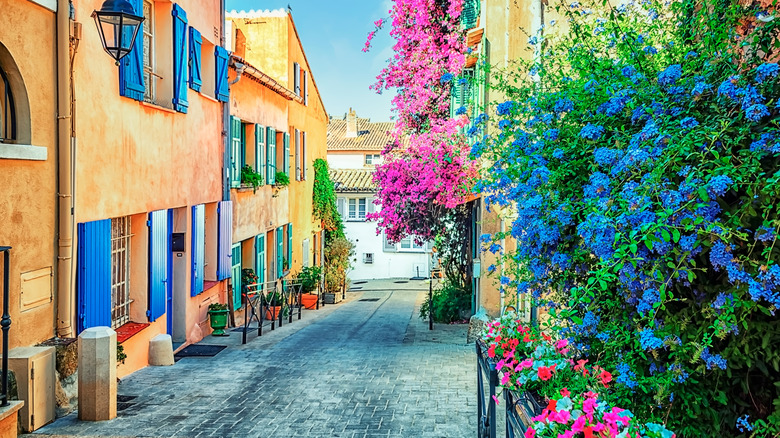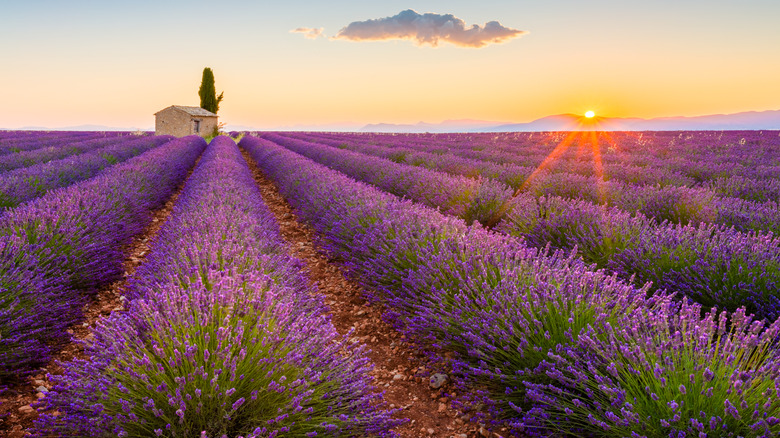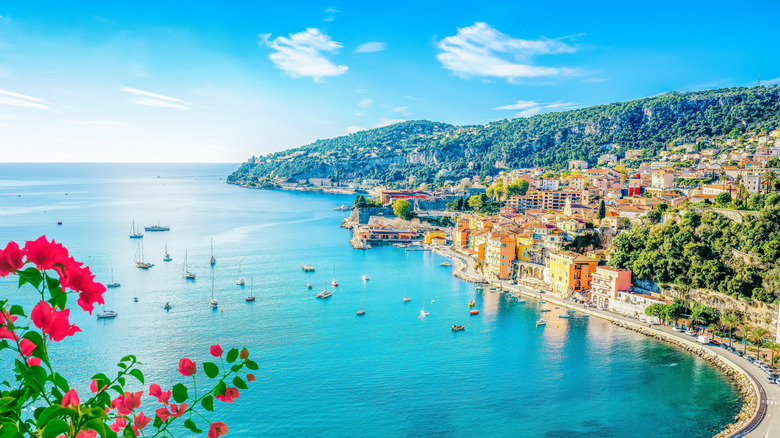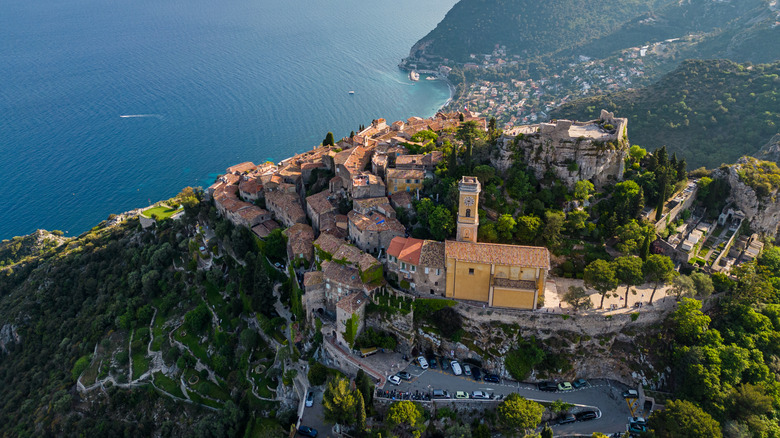These Beautiful Towns Will Make You Fall In Love With The South Of France
Beauty is in the eye of the beholder. But in the South of France, it doesn't matter whether you relish the sunshine, the Mediterranean Sea, lavender fields, preserved stone buildings bathed in vines, or clifftop views. The region has all of the above and more, making for a picture-perfect destination accessible from Marseille. It's also the ideal home base for exploring the French Riviera. With so much beauty to savor, it's tough to know where to go to breathe in the most stunning beauty in the south of France. So, Explore dug through the area's countless towns for you, finding those that outshine the rest in terms of appearance. We did this by analyzing maps, review sites, and travel articles.
To do so, we evaluated which Southern French towns were most often called "beautiful" by bloggers and media organizations. We also considered those with nicknames that convey their outlandish beauty. Plus, we looked at which villages had the most striking features, such as cobblestone streets, panoramic views, and works of art. Here are the towns where we couldn't pull out our cameras quickly enough.
Aix-en-Provence
As the former capital of Provence, Aix-en-Provence is one of the most well-known, beautiful towns on this list. It's just a half-hour drive from Marseille. Aix-en-Provence is so stunning that it was even the muse for acclaimed artist Paul Cézanne. His former home and studio are located here, and visitors can tour these spaces where the post-impressionist artist worked and drew inspiration. A view of Mont Sainte Victoire — which he painted several times — was right outside his window.
More stunning artwork can be found at the Hotel de Caumont, which is a historic mansion and rotating art museum. Devote plenty of time to soak in this elegant structure's beauty. It has opulent rooms, a blooming garden, and a café with an Instagram-worthy pink wall. Another art museum in this vibrant town is Musée Granet, which has 12,000 pieces of art from renowned artists like Rembrandt, Cézanne, and Picasso.
You might be inspired to put color on a canvas yourself after heading to Aix-en-Provence's other scenic locations, such as its flower market in Place de l'Hôtel de Ville. To further soak in Aix-en-Provence's mix of the urban and natural, walk down Cours Mirabeau. Lining this street are vendors, trees, stores, and fountains, which are a few of many in this sophisticated town. Known as the "City of a Thousand Fountains," Aix-en-Provence is home to plenty of famous fountains like Fontaine de la Rotonde, Fontaine des Neuf-Canons, and Fontaine Moussue.
Èze
Although it dates back to medieval times, Èze, a 25-minute drive from Nice, seems very much frozen in time. Cars are banned in its fortified village, which makes it even easier to enjoy the town's stone buildings, some of which are hidden around corners. With so much charm in such a small space, it's recommended to get to Èze early to experience it without crowds. Throughout the cobblestone streets, you'll see structures bathed in ivy, colorful shutters, and wrought-iron lamps, as well as beautiful panoramas.
Èze looms over the Mediterranean Sea from atop a mountain between Monaco and Nice. Rick Steves calls it a 'floating hill' town that's a must-visit for panoramic sea views. Climb to the very top of the mountain and you'll see Èze's most beautiful view at Jardin Exotique. At 1,476 feet above sea level, this garden that has cacti, sculptures, and rare flowers is nestled around the ruins of a 12th-century castle. It's all surrounded by French Riviera views.
Visitors can see more of Èze's fauna and scenery by hiking Nietzsche Way, which treks to the top of the town. Nietzsche Way got its name because it's rumored that philosopher Friedrich Nietzsche used the trail. If you time your visit correctly, you'll find a seaside market at the bottom of the trail. Here, buy seafood, bread, produce, spices, and artisan-made items while surrounded by turquoise waters. Or, to enjoy gastronomic delights with a panoramic view, dine at Èze's two-Michelin-star restaurant and hotel Chèvre D'or.
Gordes
Gordes, which is nearly an hour's drive from Avignon and atop a tall hill, is so small that its cobblestone streets can be explored in just half an hour. However, that small area packs one beautiful punch, as Gordes has been named one of the most beautiful towns in France. Its beauty has even attracted Hollywood, since movies and TV series like "A Good Year" and "Mistral's Daughter" were filmed here.
That's not due to just one landmark or stunning element, but all of them. The town is so scenic that it has long been a respite for artists, including Marc Chagall and Victor Vasarely. Plenty of art galleries — highlighting everything from paintings to sculptures — also call Gordes home, like Le Gabouton and Le Miel Peyron. But even the buildings here look like works of art, since by law, they're all required to be made of stone.
Le Château de Gordes, a castle dating back to 1031, looms over the entire town. It's now Gordes' town hall and an art museum, but one of its most popular features is its views. For even more beautiful, aerial scenery, head to Gordes' famous viewpoint that you've likely already seen on a postcard. However, panoramic views of Provence can be found on every corner here. Or, find serenity at the nearly 1,000-year-old Cistercian monastery Abbey de Senanque, which is surrounded by colorful lavender fields. The Musée de la Lavande (lavender museum) is also nearby in a classic Luberon farmhouse.
Lourmarin
"A Good Year" might have been filmed in Gordes, but the book it was based on was inspired by Lourmarin's beauty. The town is just an hour's drive from Avignon. Author Peter Mayle lived in Lourmarin, as did many other cultural figures like French writer Albert Camus and author Henri Bosco. But with its lush valley setting, restored historic buildings covered in ivy, and narrow streets, it's hard not to be charmed by small-town Lourmarin. It was even named as one of the most beautiful villages in France. Rick Steves also calls it one of France's best hill towns.
One of the town's most beautiful features is its 15th-century castle, Château de Lourmarin. You can also just walk the alleys of Lourmarin to enjoy its beauty, as it's home to plenty of picturesque art galleries, shops, boutiques, and cafés. But shoppers shouldn't miss out on Lourmarin's large and colorful Friday market, where they can buy items like jams, olive oil, meats, cheeses, honey, and more. If all that shopping makes you thirsty, then stop by local vineyard Château Constantin, which offers free wine tastings complemented by scenic views.
Rocamadour
Perched on a cliff overlooking the Alzou Valley, the panoramic sights from the three-tiered Rocamadour are ethereal. That's especially true from the top level, where people can see ruins and also visit an observation deck. Visitors might also see eagles here. Rocamadour is so stunning that it's earned the title of one of France's most beautiful villages. It's a 45-minute drive from the Brive–Souillac Airport.
Plus, the town, a UNESCO World Heritage Site, is so otherworldly that it's the site of miracles. Christian pilgrims have traveled to this 390-foot-high town for generations to see its religious sites, one of which is a 12th-century Black Madonna statue. Supposedly, whenever the statue performs a miracle, a bell in Rocamadour's chapel rings by itself. Just a few miracles the statue is alleged to have performed include healing people from injuries and saving sailors from storms. Visitors can see more religious beauty in Rocamadour at its Romanesque Chapelle St-Michel, which has been carved from the surrounding rock. Inside are two stunning frescoes, including one dating back to the 1200s.
Those aren't the only sites worth seeing in Rocamadour. If you visit in September, you'll be wowed by the sight of over 30 hot air balloons ascending into the skies during the free, two-day Montgolfiades of Rocamadour festival. Adding to the town's splendor is the fact that no cars are allowed here. That's especially pleasant on the lowest tier of the town, where there are stores and restaurants on cobblestone streets.
Sainte-Agnes
As we've learned through this article, many of southern France's prettiest towns are perched on mountains or cliffs, offering panoramic views of the Mediterranean Sea below. But Sainte-Agnes is, at 2,625 feet tall, the highest of them all. The town, relatively undisturbed by tourists, is the highest coastal village on the continent. It's also a 40-minute drive from Nice.
For the best views from this towering medieval enclave, trek to the top where the remnants of Château de Sainte Agnès are. Besides offering all-encompassing sights of the area, the 10th-century castle also has a beautiful, lush garden. Surrounded by stone walls, it's full of manicured shrubbery and colorful flowers for a secret garden vibe. Also offering views from up above is Fort Maginot, a former stronghold that's now a museum perched 2,559 feet high.
Even if you can't make it to the castle — since the hike is a steep one — you'll see why Sainte-Agnes was named as one of France's most beautiful villages. Many of the cobblestone streets are inaccessible to cars, making for a relaxed vibe that pays homage to the buildings' 15th-century past. Stone restaurants and shops, as well as a Baroque church, are hidden behind vaulted passageways. The quaint yellow church, dating back to 1271, includes stunning black-and-white flooring and a historic statue of Saint Agnes.
Saint-Cirq-Lapopie
Saint-Cirq-Lapopie has such a long list of accolades about its beauty that you don't need to trust our word that it belongs on this list. The popular tourist destination has been named one of the most beautiful villages in France. It was voted the favorite village in the country by the French people, as well as Japanese travel agencies. It's dubbed the "Pearl of the Lot Valley." And it's so stunning that famed writer André Breton once wrote, "Above any other place in the world, in America or Europe, Saint-Cirq is my one place of enchantment...I stopped wanting to be elsewhere." The village was also beloved by artists Henri Martin and Pierre Daura. It's an hour-and-a-half drive from the Toulouse-Blagnac Airport.
Hovering 328 feet atop a limestone cliff, Saint-Cirq-Lapopie offers panoramic views of the Lot River below from its castle ruins, one that dates back to the eighth century. That's just one taste of history here, as Saint-Cirq-Lapopie is home to 13 historic sites. And that's not even including its historic homes that date back to the 13th century. Surrounding them are charming galleries, gardens, and shops on cobblestone streets.
Saint-Paul-de-Vence
Saint-Paul-de-Vence is so picturesque that it's long been the muse of artists. Painter Marc Chagall called it home, and his surroundings became the subject of his works. He's even buried here, and some of his famed murals can be seen at a local church. Other famed people, such as composer Jacques Morale and journalist Paul Freer, were laid to rest in Saint Paul de Vence. It was also visited by Pablo Picasso, Georges Braque, and Henri Matisse. Nearly two dozen other famed artists called Saint-Paul-de-Vence home. That art-focused culture still thrives in Saint-Paul-de-Vence, which is a 30-minute drive from Nice.
Visitors can expect to see sculptures and other beautiful touches, as well as art galleries selling items such as glassware and paintings, around every corner of the cobblestone streets. Turn one corner and you'll find the Provencal-style Fontaine de Saint-Paul-de-Vence, a 17th-century fountain that was a favorite spot for artists in the early 1900s. However, age doesn't come before beauty in this pretty-as-a-painting town. Saint-Paul-de-Vence is one of the oldest medieval towns in the region.
Adding to Saint-Paul-de-Vence's beauty is that no cars are allowed here. Plus, just 300 people live in this little-known village, and it's less crowded than other towns in the French Riviera. It makes for a quaint vibe atop a tall hill. From there, visitors can enjoy country and sea views for miles. To see them from the edge of town, trek Saint-Paul-de-Vence's 16th-century ramparts.
Saint-Tropez
Saint-Tropez doesn't have the quaintness or the peaceful aura that many of the other Southern French villages on this list offer. However, what it lacks in serenity, it makes up for in glamour, making for a coastal five-star destination that attracts A-list stars. It's one of the vacation spots celebrity couples love. That's also how Saint-Tropez originally found its mass appeal, as "And God Created Woman," starring Brigette Bardot, took place here. Today, Saint-Tropez's colorful buildings are surrounded by turquoise waters, massive yachts owned by billionaires, restaurants, designer shops, and art galleries. The town's art past has a storied history, since artists such as Paul Signac and Henri Matisse visited here.
A trip to Saint-Tropez isn't complete without a hangout on the beach, and the town has plenty to choose from. A few favorites include Verde Beach, which has sun beds available for reservations, as well as the nearly 30,000-square-foot Pampelonne beach. To see it all from above, head to the 17th-century Citadel, located at the top of Saint-Tropez. Now a museum, it offers panoramic views of the sea as well as a nautical history museum from when Saint-Tropez was a major port. Stunning views can also be seen from Chapel Saint-Anne. Or for scenery without a climb, just go to one of Saint-Tropez's wineries, like Chateau Minuty. Lined with vineyards, it includes two historic buildings. Surrounding Saint-Tropez are four stately towers encompassing the commanding, medieval past of the town.
Valensole
With 300 sunny days every year, it's always a beautiful time to visit Valensole, which is an hour's drive from the Marseille Provence Airport. However, to see the best views that this village with a name that translates to "Valley of the Sun" has to offer, head here between mid-June and mid-July. That's when the village, set upon a lavender plateau in Verdon Regional Nature Park over a river valley, blooms with fields of purple lavender. It's the biggest lavender site in the country. Valensole also hosts a lavender festival on the third Sunday of each July with folk entertainment and demonstrations. The town further capitalizes on its lavender sights and smells by offering lavender ice cream and being adorned with lavender ribbons. To get more than just a lavender photo op here, head to one of Valensole's lavender distilleries to learn about how lavender oil is extracted.
Even outside of its lavender fields, the medieval hilltop village of Valensole is pretty. It's lined with stores selling lavender items like soap and candles, as well as gardens, fountains, a sundial, and cafés throughout its winding streets. Being that it lacks the over-tourism that some other French villages suffer from, many people live here. They reside in gorgeous, restored historic homes with wrought-iron balconies. The town also features a stone Provençal Romanesque church dating back to the 11th century. Valensole is quite intimate and romantic; its most popular hotel is surrounded by lavender fields.
Villefranche-sur-Mer
Nice gets all the attention when it comes to southern French beauty by the sea. But just a 15-minute drive from Nice is the more serene Villefranche-sur-Mer. It's home to one of the best beaches in the region. Free to access, the small beach's blue-green water is perfect for swimming due to its shallowness. It's also ideal for sunbathing since its shores have coarse sand. You can also just watch the fishing village's boats go by. Any traveler looking for a vibrant escape will love this quirky, colorful French beach.
Villefranche-sur-Mer's cobblestone-lined Old Town, which dates back to 1295, is equally as gorgeous and colorful. Its winding streets are dotted with flowers, courtyards, cafés, and shops. Visitors might stumble upon the Chapelle Saint-Pierre, which is ornamented with nautical-themed frescoes painted by French artist and leader of the surrealist movement Jean Cocteau. He found such beauty in Villefranche-sur-Mer that he stayed here for nearly a dozen years.
Villefranche-sur-Mer is so picturesque that over 150 movies and television shows have been filmed here, including "To Catch a Thief," "The Red Shoes," and "Emily in Paris." To get a panoramic view of the sights that make Villefranche-sur-Mer so scenic, head to the town's citadel. The stone-walled fortress dates back to the 1500s and looms over the town. It also houses museums and art galleries, including works by Goetz Boumeester and Antoniucci Volti.
Methodology
Choosing the most beautiful town in the South of France was as difficult as picking the best piece of art in the Louvre. They're all stunning in their own way, so we had to dive deep to determine the best of the best for Explore readers. To do so, we first combed through blogs written by travelers just like you to see which towns were most often deemed beautiful by regular passersby. We also considered those described as breathtaking by media organizations. Plus, we looked to see which towns were so pretty that they had nicknames conveying their beauty, like Aix-en-Provence, dubbed "City of a Thousand Fountains."
We also reviewed photos and town descriptions to see which had the most beautiful elements. The destinations that grace this list have panoramic viewpoints, cobblestone streets, pastel buildings, and priceless artwork. These works of art are only made possible because the villages have so much beauty that they have attracted famous artists over the generations.
